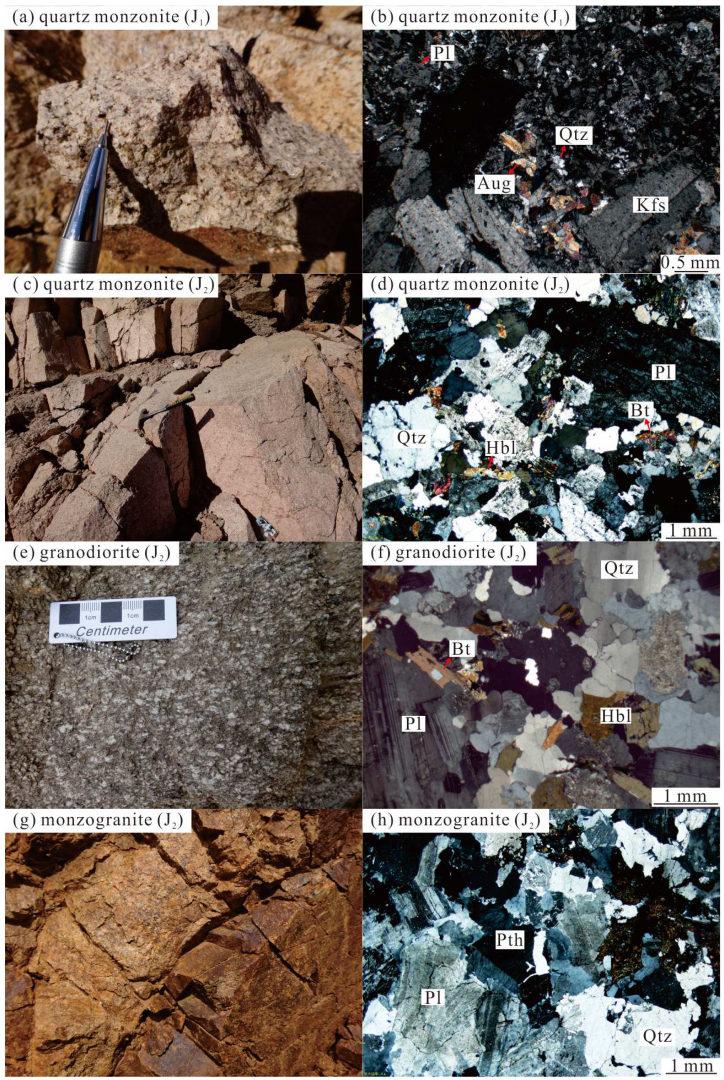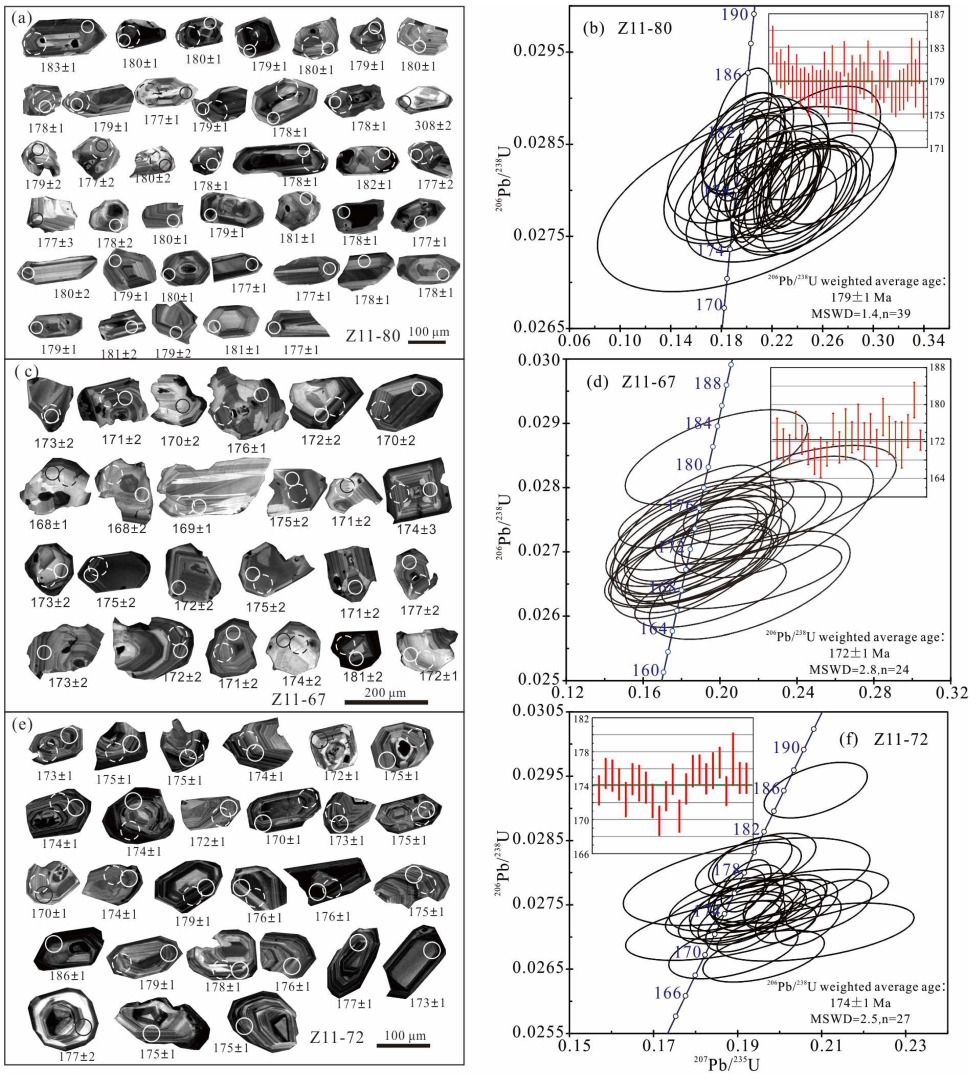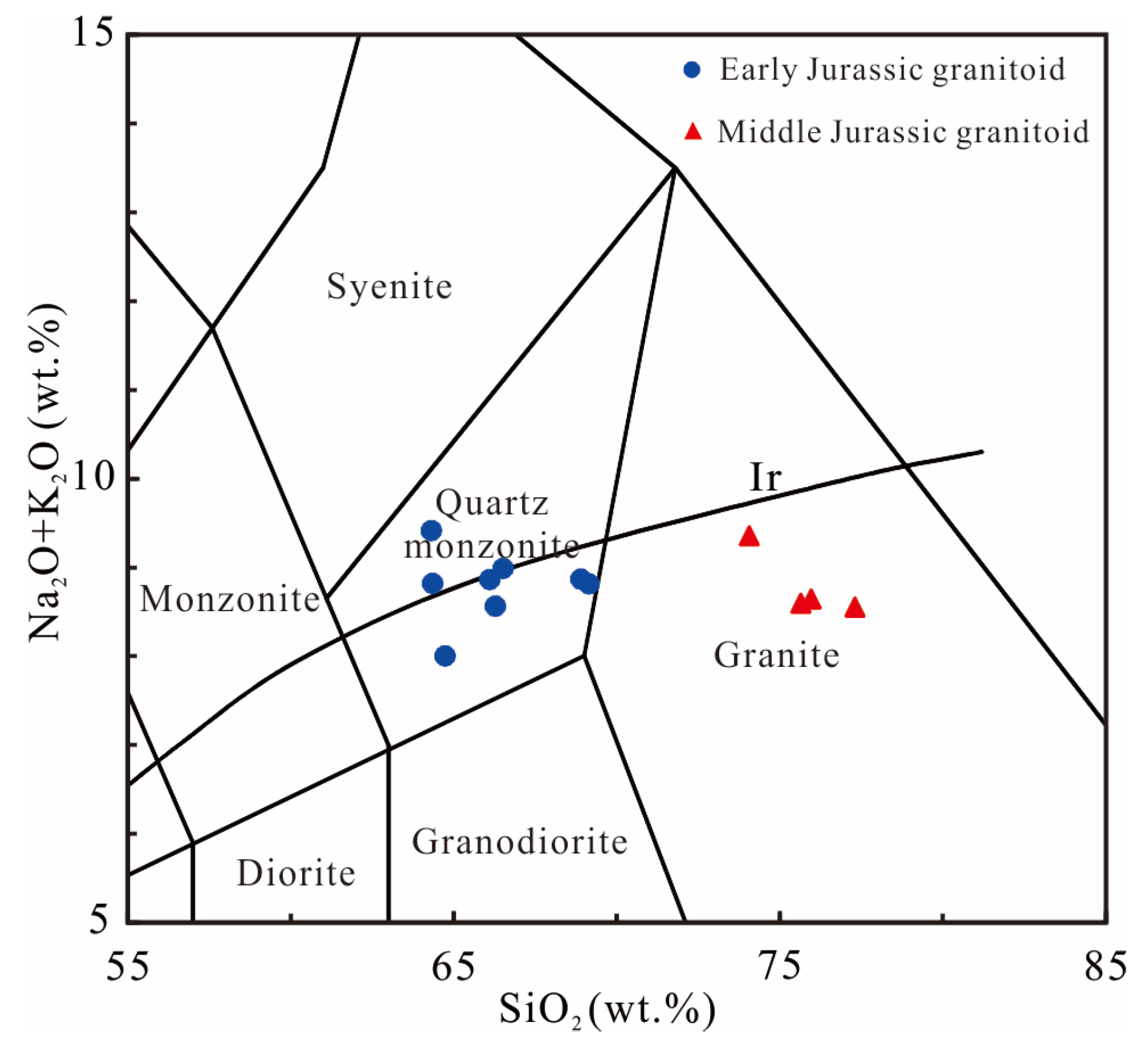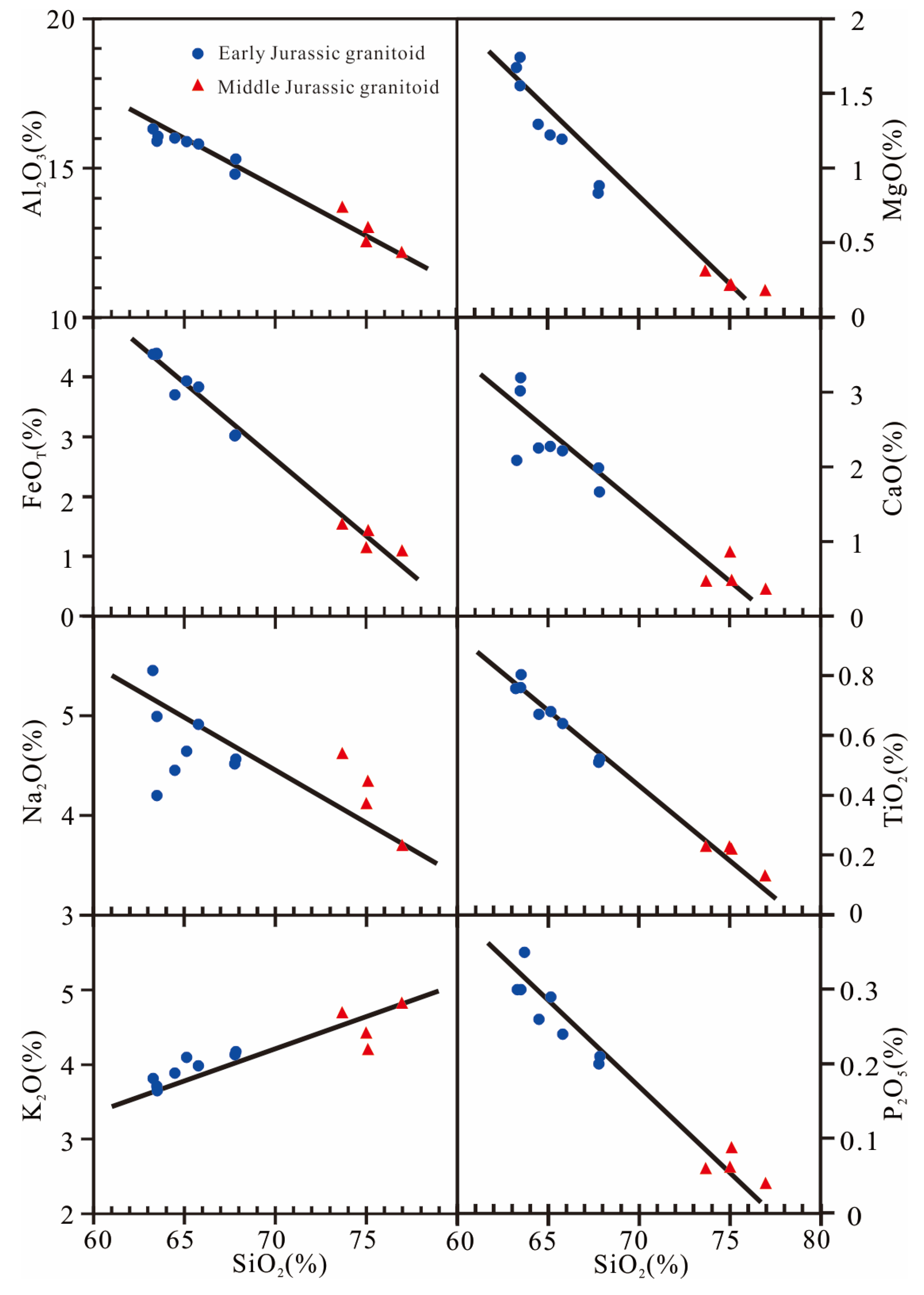Petrogenesis and Tectonic Setting of the Early and Middle Jurassic Granitoids in the Chaihe Area, Central Great Xing’an Range, NE China
Abstract
:1. Introduction
2. Geological Setting and Geological Characteristics of Plutons

| Age | Rock Type | Texture | Mineral Content and Characteristics | Samples No. |
|---|---|---|---|---|
| Early Jurassic | Quartz monzonite | Porphyritic textures, about 70% phenocrysts and about 30% matrix with aplitic textures and massive structures | Quartz (15%±), plagioclase (45%±), alkali feldspars (35%±), and mafic minerals (5%±) such as primary biotite, augite, and secondary epidote (Figure 3a,b). The main types of plagioclase are andesine and labradorite. Quartz grains are anhedral, plagioclase grains show polysynthetic twins, and some alkali feldspar grains have Carlsbad twins. | Zircon U-Pb and Hf Isotope: Z11-80 Whole-Rock: Z11-80, B1245-1, B4239-2, B4239-3, B4241-1, B4246-1 B4246-2, B4247-1 |
| Middle Jurassic | Quartz monzonite | Fine-grained granitic textures, and massive structures | Alkali feldspars (30%±), plagioclase (45%±), quartz (15%±), and a small amount of hornblende (5%±) and biotite (5%±). Their mafic minerals have undergone intense chlorite alteration and carbonation (Figure 3c,d). | |
| Granodiorite | Medium-to fine-grained granitic textures, and massive structures | Alkali feldspar (15%±), plagioclase (45%±), quartz (28%±), and a small amount of mafic minerals (12%±) such as biotite and hornblende (Figure 3e,f). In addition, their accessory minerals include sphene, apatite, and magnetite. Quartz grains are anhedral, plagioclase grains have polysynthetic twins, and hornblende grains are generally euhedral. | ||
| Monzogranite | Medium- to fine-grained granitic textures, massive structures, and local cataclastic structures | Quartz (30%±), plagioclase (35%±), perthite (20%±), orthoclase (10%±), and biotite (5%±) (Figure 3g,h). Quartz grains are anhedral and fill between other mineral particles; perthite grains show striated twins; orthoclase grains have Carlsbad twins. | Zircon U-Pb and Hf Isotope: Z11-67, Z11-72 Whole-Rock: Z11-72, B1227-1 B3230-4, B3234-1 |

3. Analytical Methods
3.1. Zircon U-Pb Dating
3.2. In Situ Zircon Hf Isotope Analysis
3.3. Whole-Rock Major- and Trace-Element Analysis
4. Analytical Results
4.1. Zircon U-Pb Ages
4.2. In Situ Zircon Hf Isotopic Composition
4.3. Major and Trace Elements
5. Discussion
5.1. Distribution of the Early and Middle Jurassic Granitoids in the Great Xing’an Range
5.2. Petrogenesis of the Early and Middle Jurassic Granitoids
5.2.1. Petrogenetic Types of Granitoids
5.2.2. Magma Source
5.2.3. Magma Evolution
5.3. Tectonic Setting for the Formation of the Early and Middle Jurassic Granitoids and Its Constraints on the Southward Subduction of the Mongol-Okhotsk Oceanic Plate
6. Conclusions
Supplementary Materials
Author Contributions
Funding
Data Availability Statement
Acknowledgments
Conflicts of Interest
References
- Sengör, A.M.C.; Natal’in, B.A.; Burtman, V.S. Evolution of the Altaid tectonic col-lage and Palaeozoic crustal growth in Eurasia. Nature 1993, 364, 299–307. [Google Scholar] [CrossRef]
- Mossakovsky, A.A.; Ruzhentsev, S.V.; Samygin, S.G.; Kheraskova, T.N. Central Asian fold belt: Geodynamic evolution and formation history. Geotectonics 1994, 24, 445–474. [Google Scholar]
- Xiao, W.J.; Windley, B.F.; Hao, J.; Zhai, M.G. Accretion leading to collision and the Permian Solonker suture, Inner Mongolia, China: Termination of the central Asian oro-genic belt. Tectonics 2003, 22, 1069. [Google Scholar] [CrossRef] [Green Version]
- Jahn, B.M. The Central Asian Orogenic Belt and growth of the continental crust in the Phanerozoic. In Aspects of the Tectonic Evolution of China; Malpas, J., Fletcher, C.J.N., Ali, J.R., Aitchison, J.C., Eds.; Geological Society: London, UK, 2004; Volume 226, pp. 73–100. [Google Scholar] [CrossRef]
- Kovalenko, V.I.; Yarmolyuk, V.V.; Kovach, V.P.; Kotov, A.B.; Kozakov, I.K.; Salni-kova, E.B.; Larin, A.M. Isotope provinces, mechanisms of generation and sources of the continental crust in the Central Asian mobile belt: Geological and isotopic evidence. J. Asian Earth Sci. 2004, 23, 605–627. [Google Scholar] [CrossRef]
- Windley, B.F.; Alexeiev, D.; Xiao, W.J.; Kröner, A.; Badarch, G. Tectonic models for accretion of the Central Asian orogenic belt. J. Geol. Soc. 2007, 164, 31–47. [Google Scholar] [CrossRef] [Green Version]
- Eizenhöfer, P.R.; Zhao, G.C.; Zhang, J.; Sun, M. Timing of final closure of the Paleo-Asian Ocean along the Solonker Suture Zone: Constraints from the provenance analysis of detrital zircons from Permian sedimentary rocks. Tectonics 2014, 33, 441–463. [Google Scholar] [CrossRef] [Green Version]
- Xiao, W.J.; Santosh, M. The western Central Asian orogenic belt: A window to ac-cretionary orogenesis and continental growth. Gondwana Res. 2014, 25, 1429–1444. [Google Scholar] [CrossRef]
- Cai, K.D.; Sun, M.; Yuan, C.; Zhao, G.C.; Xiao, W.J.; Long, X.P.; Wu, F.Y. Geochronological and geochemical study of mafic dykes from the northwest Chinese Altai: Implications for petrogenesis and tectonic evolution. Gondwana Res. 2010, 18, 638–652. [Google Scholar] [CrossRef]
- Cai, K.D.; Sun, M.; Yuan, C.; Zhao, G.C.; Xiao, W.J.; Long, X.P. Keketuohai mafic–ultramafic complex in the Chinese Altai, NW China: Petrogenesis and geodynamic sig-nificance. Chem. Geol. 2012, 294–295, 26–41. [Google Scholar] [CrossRef]
- Cai, K.D.; Sun, M.; Buslov, M.M.; Yuan, C.; Zhao, G.C.; Long, X.P. Zircon U–Pb geochronology and Hf isotopic composition of granitoids in Russian Altai Mountain, Central Asian Orogenic Belt. Am. J. Sci. 2014, 314, 580–612. [Google Scholar] [CrossRef]
- Geng, H.Y.; Sun, M.; Yuan, C.; Zhao, G.C.; Xiao, W.J. Geochemical and geochronological study of early Carboniferous volcanic rocks from the West Junggar: Petrogenesis and tectonic implications. J. Asian Earth Sci. 2011, 42, 854–866. [Google Scholar] [CrossRef]
- Jiang, Y.D.; Sun, M.; Zhao, G.C.; Yuan, C.; Xiao, W.J.; Xia, X.P.; Long, X.P.; Wu, F.Y. Precambrian detrital zircons in the early Paleozoic Chinese Altai: Their provenance and implications for the crustal growth of central Asia. Precambr. Res. 2011, 189, 140–154. [Google Scholar] [CrossRef]
- Yuan, C.; Sun, M.; Xu, Y.G.; Zhao, G.C.; Xiao, W.J.; Long, X.P.; Yin, J.Y. Oceanic lithospheric mantle beneath the continental crust of the Chinese Altai. J. Geol. Soc. 2011, 168, 995–1000. [Google Scholar] [CrossRef]
- Zhang, J.E.; Xiao, W.J.; Han, C.M.; Ao, S.J.; Yuan, C.; Sun, M.; Geng, H.Y.; Zhao, G.C.; Guo, Q.Q.; Ma, C. Kinematics and age constraints of deformation in a Late Carboniferous accretionary complex in Western Junggar, NW China. Gondwana Res. 2011, 19, 958–974. [Google Scholar] [CrossRef]
- Guo, F.; Li, H.X.; Fan, W.M.; Li, J.Y.; Zhao, L.; Huang, M.W.; Xu, W.L. Early Jurassic subduction of the Paleo-Pacific Ocean in NE China: Petrologic and geochemical evidence from the Tumen mafic intrusive complex. Lithos 2015, 224–225, 46–60. [Google Scholar] [CrossRef]
- Wang, F.; Xu, W.L.; Xing, K.C.; Wang, Y.N.; Zhang, H.H.; Wu, W.; Sun, C.Y.; Ge, W.C. Final Closure of the Paleo-Asian Ocean and Onset of Subduction of Paleo-Pacific Ocean: Constraints From Early Mesozoic Magmatism in Central Southern Jilin Province, NE China. J. Geophys. Res. Solid Earth 2019, 124, 2601–2622. [Google Scholar] [CrossRef]
- Zhang, B.; Guo, F.; Zhang, X.B.; Wu, Y.M.; Wang, G.Q.; Zhao, L. Pacific Ocean in the coastal region of SE China: Petrological and geochemical constraints from the mafic intrusions. Lithos 2019, 334–335, 8–24. [Google Scholar] [CrossRef]
- Li, Z.Q.; Chen, J.L.; Zou, H.; Wang, C.S.; Meng, Q.A.; Liu, H.L.; Wang, S.Z. Mesozo-ic–Cenozoic tectonic evolution and dynamics of the Songliao Basin, NE Asia: Implica-tions for the closure of the Paleo-Asian Ocean and Mongol-Okhotsk Ocean and subduction of the Paleo-Pacific Ocean. Earth Sci. Rev. 2021, 218, 103471. [Google Scholar] [CrossRef]
- Wu, F.Y.; Sun, D.Y.; Ge, W.C.; Zhang, Y.B.; Grant, M.L.; Wilde, S.A.; Jahn, B.M. Geochronology of the Phanerozoic Granitoids in Northeastern China. J. Asian Earth Sci. 2011, 41, 1–30. [Google Scholar] [CrossRef] [Green Version]
- Shi, L.; Zheng, C.; Yao, W.; Li, J.; Cui, F.; Gao, F.; Gao, Y.; Xu, J.; Han, X. Geochronological framework and tectonic setting of the granitic magmatism in the Chaihe–Moguqi region, central Great Xing’an Range, China. J. Asian Earth Sci. 2015, 113, 443–453. [Google Scholar] [CrossRef]
- Yang, W.B.; Niu, H.C.; Cheng, L.R.; Shan, Q.; Li, N.B. Geochronology, geochemistry and geodynamic implications of the Late Mesozoic volcanic rocks in the southern Great Xing’an Mountains, NE China. J. Asian Earth Sci. 2015, 113, 454–470. [Google Scholar] [CrossRef]
- Ge, W.C.; Lin, Q.; Sun, D.Y.; Wu, F.Y.; Won, C.K.; Lee, M.W.; Jin, M.S.; Yun, S.H. Geochemical Characteristics of the Mesozoic Basalts in Da Hinggan Ling: Evidence of the Mantle-crust Interaction. Acta Petrol. Sin. 1999, 15, 397–407, (In Chinese with English Abstract). [Google Scholar]
- Fan, W.M.; Guo, F.; Wang, Y.J.; Lin, G. Late Mesozoic Calcalkaline Volcanism of Post-orogenic Extension in the Northern Da Hinggan Mountains, Northeastern China. J. Volcanol. Geotherm. Res. 2003, 121, 115–135. [Google Scholar] [CrossRef]
- Meng, Q.R. What drove Late Mesozoic Extension of the Northern China-Mongolia Tract? Tectonophysics 2003, 369, 155–174. [Google Scholar] [CrossRef]
- Zhang, J.H.; Gao, S.; Ge, W.C.; Wu, F.Y.; Yang, J.H.; Wilde, S.A.; Li, M. Geochronology of the Mesozoic Volcanic Rocks in the Great Xing’an Range, Northeastern China: Implications for Subduction-induced Delamination. Chem. Geol. 2010, 276, 144–165. [Google Scholar] [CrossRef]
- Wang, F.; Zhou, X.H.; Zhang, L.C.; Ying, J.F.; Zhang, Y.T.; Wu, F.Y.; Zhu, R.X. Late Mesozoic Volcanism in the Great Xing’an Range (NE China): Timing and Implications for the Dynamic Setting of NE Asia. Earth Planet. Sci. Lett. 2006, 251, 179–198. [Google Scholar] [CrossRef]
- Ying, J.F.; Zhou, X.H.; Zhang, L.C.; Wang, F. Geochronological Framework of Mesozoic Volcanic Rocks in the Great Xing’an Range, NE China, and Their Geodynamic Implications. J. Asian Earth Sci. 2010, 39, 786–793. [Google Scholar] [CrossRef]
- Wu, F.Y.; Jahn, B.M.; Wilde, S.A.; Lo, C.H.; Yui, T.F.; Lin, Q.; Ge, W.C.; Sun, D.Y. Highly Fractionated I-type Granites in NE China (I): Geochronology and petrogenesis. Lithos 2003, 66, 241–273. [Google Scholar] [CrossRef]
- Liu, H.; Li, Y.; He, H.; Huangfu, P.; Liu, Y. Two-phase southward subduction of the Mongol-Okhotsk oceanic plate constrained by Permian-Jurassic granitoids in the Erguna and Xing’an massifs (NE China). Lithos 2018, 304–307, 347–361. [Google Scholar] [CrossRef]
- Zhang, S.H.; Zhao, Y.; Song, B.; Hu, J.M.; Liu, S.W.; Yang, Y.H.; Chen, F.K.; Liu, X.M.; Liu, J. Contrasting Late Carboniferous and Late Permian-Middle Triassic Intrusive Suites from the Northern Margin of the North China Craton: Geochronology, Petrogenesis, and Tectonic Implications. Geol. Soc. Am. Bull. 2009, 121, 181–200. [Google Scholar] [CrossRef]
- Xu, W.L.; Pei, F.P.; Wang, F.; Meng, E.; Ji, W.Q.; Yang, D.B.; Wang, W. Spatial–temporal Relationships of Mesozoic Volcanic Rocks in NE China: Constraints on Tectonic Overprinting and Transformations Between Multiple Tectonic Regimes. J. Asian Earth Sci. 2013, 74, 167–193. [Google Scholar] [CrossRef]
- Shi, L.; Tang, Z.; Zheng, C.Q.; Qin, T.; Zhang, L.D.; Wang, Y.; Qian, C.; Yang, F. Genesis and Tectonic Significance of Late Jurassic Granitoids in Chaihe Region, Central Great Xing’an Range, NE China. J. Jilin Univ. 2020, 50, 112–128, (In Chinese with English Abstract). [Google Scholar]
- Geng, J.Z.; Li, H.K.; Zhang, J.; Zhou, H.Y.; Li, H.M. Zircon Hf Isotope Analysis by Means of LA-MC-ICP-MS. Geol. Bull. China 2011, 30, 1508–1513, (In Chinese with English Abstract). [Google Scholar]
- Scherer, E.E.; Munker, C.; Mezger, K. Calibration of the Lutetium–Hafnium clock. Science 2001, 293, 683–687. [Google Scholar] [CrossRef]
- Griffin, W.L.; Pearson, N.J.; Belousova, E.; Jackson, S.V.; Van Achterbergh, E.; O’Reilly, S.Y.; Shee, S.R. The Hf Isotope Composition of Cratonic Mantle: LAM-MC-ICPMS Analysis of Zircon Megacrysts in Kimberlites. Geochim. Cosmochim. Acta 2000, 64, 133–147. [Google Scholar] [CrossRef]
- Nowell, G.M.; Kempton, P.D.; Noble, S.R.; Fitton, J.G.; Saunders, A.D.; Mahoney, J.J.; Taylor, R.N. High Precision Hf Isotope Measurements of MORB and OIB by Thermal Ionization Mass Spectrometry: Insights Into the Depleted Mantle. Chem. Geol. 1998, 149, 211–233. [Google Scholar] [CrossRef]
- Amelin, Y.; Lee, D.C.; Halliday, A.N. Early–middle Archaean Crustal Evolution Deduced from Lu–Hf and U–Pb Isotopic Studies of Single Zircon Grains. Geochim. Cosmochim. Acta 2000, 64, 4205–4225. [Google Scholar] [CrossRef]
- Li, X.H.; Li, Z.X.; Zhou, H.W.; Liu, Y.; Kinny, P.D. U-Pb zircon geochronology, geochemistry and Nd isotopic study of Neoproterozoic bimodal volcanic rocks in the Kangdian rift of South China: Implications for the initial rifting of Rodinia. Precambrian Res. 2002, 113, 135–154. [Google Scholar] [CrossRef]
- Yang, J.H.; Wu, F.Y.; Shao, J.A.; Wilde, S.A.; Xie, L.W.; Liu, X.M. Constraints on the Timing of Uplift of the Yanshan Fold and Thrust Belt, North China. Earth Planet. Sci. Lett. 2006, 246, 336–352. [Google Scholar] [CrossRef]
- Peccerillo, A.; Taylor, S.R. Geochemistry of Eocene calc-alkaline volcanic rocks from the Kastamonu area, Northern Turkey. Contrib. Miner. Petrol. 1976, 58, 63–81. [Google Scholar] [CrossRef]
- Middlemost, E.A. Magmas and Magmatic Rocks; Longman: London, UK, 1985; pp. 1–266. [Google Scholar]
- Maniar, P.D.; Piccoli, P.M. Tectonic discrimination of granitoids. Geol. Soc. Am. Bull. 1989, 101, 635–643. [Google Scholar] [CrossRef]
- Middlemost, E.A. Naming materials in the magma/igneous rock system. Earth Sci. Rev. 1994, 37, 215–224. [Google Scholar] [CrossRef]
- Irvine, T.N.; Baragar, W.R.A. A Guide to the Chemical Classification of the Common Volcanic Rocks. Can. J. Earth Sci. 1971, 8, 523–548. [Google Scholar] [CrossRef]
- Sun, S.; McDonough, W.F. Chemical and isotopic systematics of oceanic basalts: Implications for mantle composition and processes. Geol. Soc. Lond. Spec. Publ. 1989, 42, 313–345. [Google Scholar] [CrossRef]
- Gao, F.; Xu, W.; Yang, D.; Pei, F.; Liu, X.; Hu, Z. LA-ICP-MS Zircon U–Pb Dating from Granitoids in Southern Basement of Songliao Basin: Constraints on Ages of the Basin Basement. Sci. China Ser. D Earth Sci. 2007, 50, 995–1004. [Google Scholar] [CrossRef]
- Ge, W.C.; Wu, F.Y.; Zhou, C.Y.; Zhang, J.H. Zircon U-Pb Ages and Its Significance of the Mesozoic Granites in the Wulanhaote Region, Central Da Hinggan Mountain. Acta Petrol. Sin. 2005, 21, 749–762, (In Chinese with English Abstract). [Google Scholar]
- Yu, H.C.; He, Z.H.; Sui, Z.M.; Dong, Y.; Zhu, K. Determination and geological implication of the Middle Jurassic postcollisional granitoids in Taerqi area, central Great Xing’an Range. Acta Petrol. Sin. 2020, 36, 3721–3740, (In Chinese with English Abstract). [Google Scholar] [CrossRef]
- Chappell, B.W.; White, A.J.R. Two constrasting granite types. Pac. Geol. 1974, 8, 173–174. [Google Scholar]
- Zhao, K.D.; Jiang, S.Y.; Yang, S.Y.; Dai, B.Z.; Lu, J.J. Mineral chemistry, trace elements and Sr-Nd-Hf isotope geochemistry and petrogenesis of Cailing and Furong granites and mafic enclaves from the Qitianling batholith in the Shi-Hang zone. South China. Gondwana Res. 2012, 22, 310–324. [Google Scholar] [CrossRef]
- Whalen, J.B.; Currie, K.L.; Chappell, B.W. A-type Granites: Geochemical Characteristics, Discrimination and Petrogenesis. Contrib. Mineral. Petrol. 1987, 95, 407–419. [Google Scholar] [CrossRef]
- Boehnke, P.; Watson, E.B.; Trail, D.; Harrison, T.M.; Schmitt, A.K. Zircon saturation re-revisited. Chem. Geol. 2013, 351, 324–334. [Google Scholar] [CrossRef]
- Clemens, J.D.; Holloway, J.R.; White, A.J.R. Origin of an A-type granite: Experimental constraints. Am. Mineral. 1986, 71, 317–324. [Google Scholar]
- King, P.L.; White, A.J.R.; Chappell, B.W.; Allen, C.M. Characterization and Origin of Aluminous A-type Granites from the Lachlan Fold Belt, Southeastern Australia. J. Petrol. 1997, 38, 371–391. [Google Scholar] [CrossRef]
- Wu, F.Y.; Li, X.H.; Yang, J.H.; Zheng, Y.F. Discussions on the Petrogenesis of Granites. Acta Petrol. Sin. 2007, 23, 1217–1238, (In Chinese with English Abstract). [Google Scholar]
- Eby, G.N.; Woolley, A.R.; Din, V.I.C.; Platt, G. Geochemistry and Petrogenesis of Nepheline Syenites: Kasungu–Chipala, Ilomba, and Ulindi Nepheline Syenite Intrusions, North Nyasa Alkaline Province, Malawi. J. Petrol. 1998, 39, 1405–1424. [Google Scholar] [CrossRef]
- Litvinovsky, B.A.; Jahn, B.M.; Eyal, M. Mantle-derived sources of syenites from the A-type igneous suites—New approach to the provenance of alkaline silicic magmas. Lithos 2015, 232, 242–265. [Google Scholar] [CrossRef]
- Mingram, B.; Trumbull, R.B.; Littman, S.; Gerstenberger, H. A petrogenetic study of anorogenic felsic magmatism in the Cretaceous Paresis ring complex, Namibia: Evidence for mixing of crust and mantle-derived components. Lithos 2000, 54, 1–22. [Google Scholar] [CrossRef]
- Martin, R.F. A-type granites of crustal origin ultimately result from open-system fenitization-type reactions in an extensional environment. Lithos 2006, 91, 125–136. [Google Scholar] [CrossRef]
- Barth, M.G.; McDonough, W.F.; Rudnick, R.L. Tracking the budget of Nb and Ta in the continental crust. Chem. Geol. 2000, 165, 197–213. [Google Scholar] [CrossRef]
- Rudnick, R.L.; Fountain, D.M. Nature and composition of the continental crust: A lower crustal perspective. Rev. Geophys. 1995, 33, 267–309. [Google Scholar] [CrossRef] [Green Version]
- Taylor, S.R.; Mclennan, S.M. The Continental Crust: Its Composition and Evolution; Blackwell Scientific Publish: Hoboken, NJ, USA, 1985. [Google Scholar]
- Othman, D.B.; White, W.M.; Patchett, J. The Geochemistry of Marine Sediments, Island Arc Magma Genesis, and Crust-mantle Recycling. Earth Planet. Sci. Lett. 1989, 94, 1–21. [Google Scholar] [CrossRef]
- Plank, T.; Langmuir, C.H. The Chemical Composition of Subducting Sediment and Its Consequences for the Crust and Mantle. Chem. Geol. 1998, 145, 325–394. [Google Scholar] [CrossRef]
- Wu, F.Y.; Sun, D.Y.; Lin, Q. Petrogenesis of the Phanerozoic Granites and Crustal Growth in Northeast China. Acta Petrol. Sin. 1999, 15, 181–189, (In Chinese with English Abstract). [Google Scholar]
- Liu, J.X.; Liu, C.; Deng, J.F.; Luo, Z.H.; He, G.Q.; Liu, Q. Igneous Records of Mongolia–Okhotsk Ocean Subduction: Evidence from Granitoids in the Greater Khingan Mountains. Minerals 2023, 13, 493. [Google Scholar] [CrossRef]
- Pearce, J.A.; Harris, N.B.W.; Tindle, A.G. Trace Element Discrimination Diagrams for the Tectonic Interpretation of Granitic Rocks. J. Petrol. 1984, 25, 956–983. [Google Scholar] [CrossRef] [Green Version]
- Harris, N.B.W.; Pearce, J.A.; Tindle, A.G. Geochemical Characteristics of Collision-Zone Magmatism//Coward MP, Ries AC. Collision Tectonics. Geol. Soc. Lond. Spec. Publ. 1986, 19, 67–81. [Google Scholar] [CrossRef]
- Tang, J.; Xu, W.; Wang, F.; Ge, W. Subduction History of the Paleo-Pacific Slab Beneath Eurasian Continent: Mesozoic-Paleogene Magmatic Records in Northeast Asia. Sci. China Earth Sci. 2018, 61, 527–559. [Google Scholar] [CrossRef]
- Cogné, J.P.; Kravchinsky, V.A.; Halim, N.; Hankard, F. Late Jurassic-Early Cretaceous Closure of the Mongol-Okhotsk Ocean Demonstrated by New Mesozoic Palaeomagnetic Results from the Trans-Baikal Area (SE Siberia). Geophys. J. Int. 2005, 163, 813–822. [Google Scholar] [CrossRef] [Green Version]
- Zonenshain, L.P.; Kuzmin, M.L.; Natapov, L.M. Geology of the USSR: A Plate-Tectonics Synthesis; Geodynamics Series; American Geophysical Union: Washington, DC, USA, 1990; Volume 21, pp. 1–242. [Google Scholar]
- Zorin, Y.A. Geodynamics of the Western Part of the Mongolia-Okhotsk Collisional Belt, Trans-Baikal Region (Russia) and Mongolia. Tectonophysics 1999, 306, 33–56. [Google Scholar] [CrossRef] [Green Version]
- Kravchinsky, V.A.; Cogné, J.P.; Harbert, W.P.; Kuzmin, M.I. Evolution of the Mongol-Okhotsk Ocean as Constrained by New Palaeomagnetic Data from the Mongol-Okhotsk Suture Zone, Siberia. Geophys. J. Int. 2002, 148, 34–57. [Google Scholar] [CrossRef] [Green Version]
- Sorokin, A.A.; Yarmolyuk, V.V.; Kotov, A.B.; Sorokin, A.P.; Kudryashov, N.M.; Tzzin’i, L. Geochronology of Triassic-Jurassic Granitoids in the Southern Framing of the Mongol-Okhotsk Fold Belt and the Problem of Early Mesozoic Granite Formation in Central and Eastern Asia. Dokl. Earth Sci. 2004, 399, 1091–1094. [Google Scholar]
- Badarch, G.; Dickson, C.W.; Windley, B.F. A New Terrane Subdivision for Mongolia: Implications for the Phanerozoic Crustal Growth of Central Asia. J. Asian Earth Sci. 2002, 21, 87–110. [Google Scholar] [CrossRef]
- Tang, J.; Xu, W.L.; Wang, F.; Zhao, S.; Wang, W. Early Mesozoic Southward Subduction History of the Mongol–Okhotsk Oceanic Plate: Evidence from Geochronology and Geochemistry of Early Mesozoic Intrusive Rocks in the Erguna Massif, NE China. Gondwana Res. 2016, 31, 218–240. [Google Scholar] [CrossRef]
- Shi, L.; Tang, Z.; Zhang, Y.J.; Yang, L. Sedimentary environment and geochemistry of the Middle Jurassic Wanbao Formation in Suolun area, middle Daxinganling Mountains. Geol. Resour. 2022, 31, 579–587+605, (In Chinese with English Abstract). [Google Scholar] [CrossRef]









Disclaimer/Publisher’s Note: The statements, opinions and data contained in all publications are solely those of the individual author(s) and contributor(s) and not of MDPI and/or the editor(s). MDPI and/or the editor(s) disclaim responsibility for any injury to people or property resulting from any ideas, methods, instructions or products referred to in the content. |
© 2023 by the authors. Licensee MDPI, Basel, Switzerland. This article is an open access article distributed under the terms and conditions of the Creative Commons Attribution (CC BY) license (https://creativecommons.org/licenses/by/4.0/).
Share and Cite
Shi, L.; Ju, N.; Feng, Y.; Zheng, C.; Wu, Y.; Liu, X. Petrogenesis and Tectonic Setting of the Early and Middle Jurassic Granitoids in the Chaihe Area, Central Great Xing’an Range, NE China. Minerals 2023, 13, 917. https://doi.org/10.3390/min13070917
Shi L, Ju N, Feng Y, Zheng C, Wu Y, Liu X. Petrogenesis and Tectonic Setting of the Early and Middle Jurassic Granitoids in the Chaihe Area, Central Great Xing’an Range, NE China. Minerals. 2023; 13(7):917. https://doi.org/10.3390/min13070917
Chicago/Turabian StyleShi, Lu, Nan Ju, Yuhui Feng, Changqing Zheng, Yue Wu, and Xin Liu. 2023. "Petrogenesis and Tectonic Setting of the Early and Middle Jurassic Granitoids in the Chaihe Area, Central Great Xing’an Range, NE China" Minerals 13, no. 7: 917. https://doi.org/10.3390/min13070917
APA StyleShi, L., Ju, N., Feng, Y., Zheng, C., Wu, Y., & Liu, X. (2023). Petrogenesis and Tectonic Setting of the Early and Middle Jurassic Granitoids in the Chaihe Area, Central Great Xing’an Range, NE China. Minerals, 13(7), 917. https://doi.org/10.3390/min13070917






